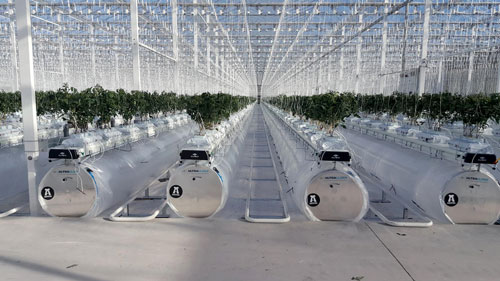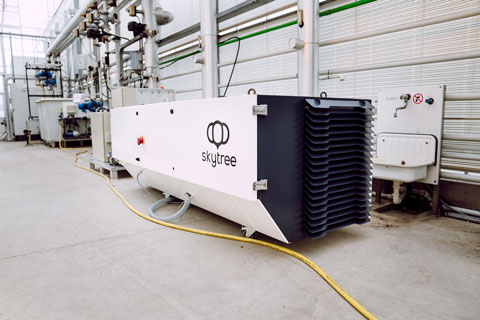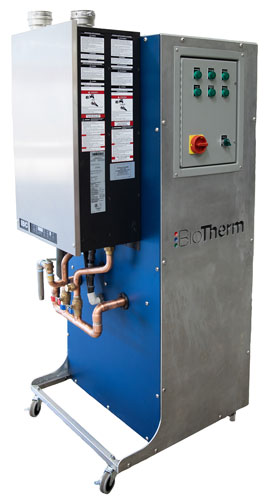8/1/2024
What’s New in CO2?
Chris Beytes
Carbon dioxide, while getting a bad rap in the press, is essential to plants. It’s basically a fertilizer. Plants soak it in through their stomata and, with the help of light energy and H2O (water), convert it into glucose and other carbohydrates and oxygen. Six molecules of CO2 and six molecules of H2O can be converted into one molecule of glucose and six molecules of oxygen—a good deal for us! We’ve known about this process, called photosynthesis, since the late 18th century.
The air around us—ambient air—contains 350 to 400 ppm of CO2, plenty for plants to do their thing. Inside a greenhouse, however, plants deplete the CO2 level down to about 300 ppm, even with ventilation, reducing growth potential.
It has been known since the middle of the last century that plants can do MORE of their thing with more CO2 (up to 1,200 ppm; more than that does not provide any benefits). Research says tomato yield can increase by up to 30% with added CO2; cucumbers perform even better, with up to 40% increase in yield; while lettuce gains up to 20% in yield, with improved nutrition and leaf quality. And the greatest gains are on the low end: going from 350 ppm to 450 ppm can yield 12% extra growth, whereas going from 600 ppm to 700 ppm only gives you 4% more growth. The flipside is worse: if you reduce CO2 from 350 to 250 ppm, plant growth drops by 19%.
That is why so many growers inject additional CO2 into their growing space using the various CO2-enrichment means at their disposal, including direct injection from tanks of the gas, capturing CO2 from the flue gases of heaters, or through CHP (combined heat and power, co-gen) equipment, in which both heat and CO2 are captured from the flue gases of an electrical generator.
But all of that is old news. Inside Grower wanted to know what’s new in CO2. Here are three ideas worth considering.

Kubo’s CO2-Negative greenhouse
“Imagine a greenhouse that absorbs more CO2 than it emits. Now that would be news,” said a Kubo video. And it is: Launched at GreenTech in the Netherlands in June, Kubo’s newest version of its Ultra-Clima “semi-closed” greenhouse is said to not only be carbon neutral, but carbon negative. Instead of injecting additional CO2 into the greenhouse through traditional means, Kubo uses exceptionally uniform and thorough airflow to ensure that plants are constantly bathed (for lack of a better term) in homogenous ambient air containing the maximum ppm of naturally occurring CO2.
Pictured: Kubo’s Ultra-Clima greenhouse keeps CO2-rich ambient air flowing around the crop. Photo courtesy of Kubo.
They discovered this simple idea in their 17,000 sq. ft. Ultra-Clima greenhouse near their Dutch headquarters. Built in 2020, the “Blue Lab” as it’s called has two zones, one controlled by computer (for autonomous growing) and one controlled by a human grower.
At first Kubo focused on reducing energy consumption, due to the tremendous energy challenges in Europe at that time. To turn down the heat, they increased air movement to keep the crop healthy and active. Surprisingly, the yield of the no-heat house beat the national average and they had no disease issues, either.
But because there was no heating, the greenhouse had to be ventilated more, which meant injected CO2 was being lost to the outside. So, they wondered: could we stop adding CO2? The Kubo Board embraced the idea, as it would head them in the direction of low-carbon cultivation. All CO2 was provided by ambient air. The key was thorough and even air movement to keep CO2-rich air surrounding the crop.
Surprisingly, they found production in the test house to be equal to the control house.
“When we stopped adding extra CO2, I expected a drop in yield,” said Danny Monté, Kubo’s grower in the Blue Lab. “But it turned out to be nothing further from the truth—output actually increased. The same happened when we started testing with less energy consumption. It turned out that we could activate crops without extra heat. The idea behind all these tests is simple: How do we achieve more output with less input?”
Moving forward, Kubo will be collaborating with one of the Netherland’s top tomato growers, and with scientists to have their results independently confirmed and published. And they’ll test more crops, including strawberries, lettuce, peppers and cannabis.

Skytree Direct Air Capture (DAC)
Direct Air Capture uses chemicals or physical means to take CO2 out of the ambient air. Skytree, with offices in the Netherlands and Oregon, has developed a machine that captures CO2 with a solid sorbent, then releases the CO2 when the sorbent is heated. With this, they can capture CO2 outside a greenhouse and release it inside a greenhouse (or any other facility requiring CO2). It requires no fossil fuel to burn, but it does require electricity to operate. They call this a “circular” CO2 supply, because unlike point-source capture, there’s no energy used to purify, liquify or transport the gas.
Pictured: The Skytree Cumulus extracts CO2 from the ambient air and releases it into the growing space. Photo courtesy of Skytree.
Skytree offers two units, the smaller Cumulus, about the size of a large home refrigerator laid down, produces 20 kg of CO2 per day. Modular, they can be stacked to meet larger demand. It’s small enough to install inside the production barn.
Coming soon is the much larger Stratus, the size of a 20-ft. shipping container, capable of capturing 2,500 kg per day.
Cost? Less than you’d think. A Cumulus, with controls, is $32,500, with maintenance contracts just $2,500 a year or so. You do have to factor in the electricity costs to operate it, however. As for the larger Stratus, they’re looking for early adopting “pioneers” who can get a discount on the product.
Currently, Skytree has one Cumulus unit operating in Ontario, Canada, at the vertical farm Fieldless and two in the Netherlands, including one at Wageningen University, where they are comparing cucumbers produced with Skytree CO2 vs. standard CO2. Two more are on their way to Belgium and Spain, and more are scheduled for installation in the U.S. and Canada.

Biotherm’s C-Gen On-Demand generators
California’s Biotherm Solutions offers a wide range of climate tools for the greenhouse and indoor farm. And while they can handle any size installation, they are known for offering solutions for smaller operations. Case in point, their C-Gen On-Demand CO2 Generator, which is a small boiler with built-in CO2 extraction designed for operations of 10,000 sq. ft. or smaller. It puts out anywhere from 33,000 to 160,000 BTU per hour that can be used for root-zone heating, irrigation water tempering or supplying a heat storage tank, while generating 1,000 to 1,200 ppm of CO2 that can be pumped into your greenhouse. Fuel source is natural gas or liquid propane. It’s scalable, if you need more capacity. For larger greenhouses or indoor farms, Biotherm can equip condensing boilers with CO2 capture equipment and controls.
Pictured: Biotherm Solutions’ C-Gen self-contained heater/CO2 generator. Photo courtesy of Biotherm.
“We have some lettuce facilities that are seeing a 25% or more increase in yield,” said Biotherm mechanical engineer Patrick Wild, adding “Some lettuce facilities have been able to substantially decrease their electrical consumption by reducing supplemental lighting.” He adds that cannabis growers have said they are seeing 30 to 50% increases in product weight when harvested.
The last tool you might consider is a sensor to detect the CO2 level in your ambient or enriched air, both for plant growth and human safety monitoring. Said Patrick, “Some local jurisdictions don’t understand how CO2 is used for plant enrichment and require many extra steps in the permit process to approve. Because of this unfamiliarity, they tend to require additional life safety systems and extra levels of redundancy.”